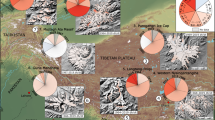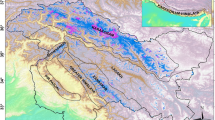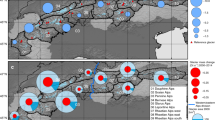Abstract
High Mountain Asia hosts the largest glacier concentration outside the polar regions. These glaciers are important contributors to streamflow in one of the most populated areas of the world. Past studies have used methods that can provide only regionally averaged glacier mass balances to assess the glacier contribution to rivers and sea level rise. Here we compute the mass balance for about 92% of the glacierized area of High Mountain Asia using time series of digital elevation models derived from satellite stereo-imagery. We calculate a total mass change of −16.3 ± 3.5 Gt yr−1 (−0.18 ± 0.04 m w.e. yr−1) between 2000 and 2016, which is less negative than most previous estimates. Region-wide mass balances vary from −4.0 ± 1.5 Gt yr−1 (−0.62 ± 0.23 m w.e. yr−1) in Nyainqentanglha to +1.4 ± 0.8 Gt yr−1 (+0.14 ± 0.08 m w.e. yr−1) in Kunlun, with large intra-regional variability of individual glacier mass balances (standard deviation within a region ∼0.20 m w.e. yr−1). Specifically, our results shed light on the Nyainqentanglha and Pamir glacier mass changes, for which contradictory estimates exist in the literature. They provide crucial information for the calibration of the models used for projecting glacier response to climatic change, as these models do not capture the pattern, magnitude and intra-regional variability of glacier changes at present.
This is a preview of subscription content, access via your institution
Access options
Access Nature and 54 other Nature Portfolio journals
Get Nature+, our best-value online-access subscription
9,800 Yen / 30 days
cancel any time
Subscription info for Japanese customers
We have a dedicated website for our Japanese customers. Please go to natureasia.com to subscribe to this journal.
Buy this article
- Purchase on SpringerLink
- Instant access to full article PDF
Prices may be subject to local taxes which are calculated during checkout



Similar content being viewed by others
Change history
18 June 2018
In the version of this Article originally published, the symbols for 'greater than' and 'less than or equal to' were inverted in the equation that defines σΔz. The original (1) and corrected (2) versions of the equation are shown below. This error did not affect the calculation of the uncertainties. In addition, erroneous values that were a remnant of an earlier version of the authors' work and higher than the final values calculated were reported for the uncertainties on ASTER estimates in Supplementary Table 4. Table 1 below shows the corrected values in bold font. These errors have now been corrected in the online versions of the Article.
References
Jacob, T., Wahr, J., Pfeffer, W. T. & Swenson, S. Recent contributions of glaciers and ice caps to sea level rise. Nature 482, 514–518 (2012).
Gardner, A. S. et al. A reconciled estimate of glacier contributions to sea level rise: 2003 to 2009. Science 340, 852–857 (2013).
Bolch, T. et al. The state and fate of Himalayan glaciers. Science 336, 310–314 (2012).
Kääb, A., Treichler, D., Nuth, C. & Berthier, E. Contending estimates of 2003–2008 glacier mass balance over the Pamir–Karakoram–Himalaya. Cryosphere 9, 557–564 (2015).
Cogley, J. G. Geodetic and direct mass-balance measurements: comparison and joint analysis. Ann. Glaciol. 50, 96–100 (2009).
Bhattacharya, A. et al. Overall recession and mass budget of Gangotri Glacier, Garhwal Himalayas, from 1965 to 2015 using remote sensing data. J. Glaciol. 62, 1115–1133 (2016).
Gardelle, J., Berthier, E., Arnaud, Y. & Kääb, A. Region-wide glacier mass balances over the Pamir-Karakoram-Himalaya during 1999–2011. Cryosphere 7, 1263–1286 (2013).
Holzer, N. et al. Four decades of glacier variations at Muztagh Ata (eastern Pamir): a multi-sensor study including Hexagon KH-9 and Pléiades data. Cryosphere 9, 2071–2088 (2015).
Pieczonka, T., Bolch, T., Junfeng, W. & Shiyin, L. Heterogeneous mass loss of glaciers in the Aksu-Tarim Catchment (Central Tien Shan) revealed by 1976 KH-9 Hexagon and 2009 SPOT-5 stereo imagery. Remote Sens. Environ. 130, 233–244 (2013).
Pieczonka, T. & Bolch, T. Region-wide glacier mass budgets and area changes for the Central Tien Shan between ∼1975 and 1999 using Hexagon KH-9 imagery. Glob. Planet. Change 128, 1–13 (2015).
Ragettli, S., Bolch, T. & Pellicciotti, F. Heterogeneous glacier thinning patterns over the last 40 years in Langtang Himal, Nepal. Cryosphere 10, 2075–2097 (2016).
Rankl, M. & Braun, M. Glacier elevation and mass changes over the central Karakoram region estimated from TanDEM-X and SRTM/X-SAR digital elevation models. Ann. Glaciol. 57, 273–281 (2016).
Vijay, S. & Braun, M. Elevation change rates of glaciers in the Lahaul-Spiti (Western Himalaya, India) during 2000–2012 and 2012–2013. Remote Sens. 8, 1038 (2016).
Huss, M. & Hock, R. A new model for global glacier change and sea-level rise. Front. Earth Sci. 3, 54 (2015).
Marzeion, B. et al. Observation-based estimates of global glacier mass change and its contribution to sea-level change. Surv. Geophys. 38, 105–130 (2017).
Kääb, A., Berthier, E., Nuth, C., Gardelle, J. & Arnaud, Y. Contrasting patterns of early twenty-first-century glacier mass change in the Himalayas. Nature 488, 495–498 (2012).
Chanard, K., Avouac, J. P., Ramillien, G. & Genrich, J. Modeling deformation induced by seasonal variations of continental water in the Himalaya region: sensitivity to Earth elastic structure. J. Geophys. Res. 119, 5097–5113 (2014).
Reager, J. T. et al. A decade of sea level rise slowed by climate-driven hydrology. Science 351, 699–703 (2016).
Yi, S. & Sun, W. Evaluation of glacier changes in high-mountain Asia based on 10 year GRACE RL05 models. J. Geophys. Res. 119, 2504–2517 (2014).
Treichler, D. & Kääb, A. ICESat laser altimetry over small mountain glaciers. Cryosphere 10, 2129–2146 (2016).
Berthier, E., Cabot, V., Vincent, C. & Six, D. Decadal region-wide and glacier-wide mass balances derived from multi-temporal ASTER satellite digital elevation models. Validation over the Mont-Blanc area. Front. Earth Sci. 4, 63 (2016).
Nuimura, T., Fujita, K., Yamaguchi, S. & Sharma, R. R. Elevation changes of glaciers revealed by multitemporal digital elevation models calibrated by GPS survey in the Khumbu region, Nepal Himalaya, 1992–2008. J. Glaciol. 58, 648–656 (2012).
Wang, D. & Kääb, A. Modeling glacier elevation change from DEM time series. Remote Sens. 7, 10117–10142 (2015).
Willis, M. J., Melkonian, A. K., Pritchard, M. E. & Ramage, J. M. Ice loss rates at the Northern Patagonian Icefield derived using a decade of satellite remote sensing. Remote Sens. Environ. 117, 184–198 (2012).
Shean, D. E. et al. An automated, open-source pipeline for mass production of digital elevation models (DEMs) from very-high-resolution commercial stereo satellite imagery. ISPRS J. Photogramm. Remote Sens. 116, 101–117 (2016).
Fischer, M., Huss, M. & Hoelzle, M. Surface elevation and mass changes of all Swiss glaciers 1980–2010. Cryosphere 9, 525–540 (2015).
Huss, M. Density assumptions for converting geodetic glacier volume change to mass change. Cryosphere 7, 877–887 (2013).
Nuimura, T. et al. The GAMDAM glacier inventory: a quality-controlled inventory of Asian glaciers. Cryosphere 9, 849–864 (2015).
Bajracharya, S. R. & Shrestha, B. The Status of Glaciers in the Hindu Kush-Himalayan Region (International Centre for Integrated Mountain Development, 2011).
Glaciers_cci consortium. Climate Research Data Package (CRDP) Technical Document (2015).
Pfeffer, W. T. et al. The Randolph Glacier Inventory: a globally complete inventory of glaciers. J. Glaciol. 60, 537–552 (2014).
Azam, M. F. et al. Meteorological conditions, seasonal and annual mass balances of Chhota Shigri Glacier, western Himalaya, India. Ann. Glaciol. 57, 328–338 (2016).
Gardelle, J., Berthier, E. & Arnaud, Y. Slight mass gain of Karakoram glaciers in the early twenty-first century. Nat. Geosci. 5, 322–325 (2012).
Huss, M. & Farinotti, D. Distributed ice thickness and volume of all glaciers around the globe. J. Geophys. Res. 117, F04010 (2012).
Yao, T. et al. Different glacier status with atmospheric circulations in Tibetan Plateau and surroundings. Nat. Clim. Change 2, 663–667 (2012).
Sevestre, H. & Benn, D. I. Climatic and geometric controls on the global distribution of surge-type glaciers: implications for a unifying model of surging. J. Glaciol. 61, 646–662 (2015).
Sherpa, S. F. et al. Contrasted surface mass balances of debris-free glaciers observed between the southern and the inner parts of the Everest region (2007–2015). J. Glaciol. (in the press).
King, O., Quincey, D. J., Carrivick, J. L. & Rowan, A. V. Spatial variability in mass loss of glaciers in the Everest region, central Himalayas, between 2000 and 2015. Cryosphere 11, 407–426 (2017).
Maussion, F. et al. Precipitation seasonality and variability over the Tibetan Plateau as resolved by the High Asia reanalysis. J. Clim. 27, 1910–1927 (2013).
Marzeion, B., Leclercq, P. W., Cogley, J. G. & Jarosch, A. H. Global reconstructions of glacier mass change during the 20th century are consistent. Cryosphere 9, 2399–2404 (2015).
Chambers, D. P. et al. Evaluation of the global mean sea level budget between 1993 and 2014. Surv. Geophys. 38, 309–327 (2017).
Radić, V. & Hock, R. Glaciers in the Earth’s hydrological cycle: assessments of glacier mass and runoff changes on global and regional scales. Surv. Geophys. 35, 813–837 (2014).
Lambrecht, A. & Mayer, C. Temporal variability of the non-steady contribution from glaciers to water discharge in western Austria. J. Hydrol. 376, 353–361 (2009).
Church, J. A. et al. in Climate Change 2013: The Physical Science Basis (eds Stocker, T. F. et al.) 1137–1216 (IPCC, Cambridge Univ. Press, 2013).
Nuth, C. & Kääb, A. Co-registration and bias corrections of satellite elevation data sets for quantifying glacier thickness change. Cryosphere 5, 271–290 (2011).
Lehner, B. & Döll, P. Development and validation of a global database of lakes, reservoirs and wetlands. J. Hydrol. 296, 1–22 (2004).
Höhle, J. & Höhle, M. Accuracy assessment of digital elevation models by means of robust statistical methods. ISPRS J. Photogramm. Remote Sens. 64, 398–406 (2009).
Rolstad, C., Haug, T. & Denby, B. Spatially integrated geodetic glacier mass balance and its uncertainty based on geostatistical analysis: application to the western Svartisen ice cap, Norway. J. Glaciol. 55, 666–680 (2009).
Berthier, E. et al. Glacier topography and elevation changes derived from Pléiades sub-meter stereo images. Cryosphere 8, 2275–2291 (2014).
Acknowledgements
We thank S. Vijay, O. King and M. Rankl for sharing elevation difference maps and glacier outlines, J. Shea, T. Bolch and W. Immerzeel for sharing basin outlines and inventories and B. Marzeion and G. Cogley for sharing gridded outputs of their estimates. We thank A. Dehecq for insightful comments and discussions. This work could not have been performed without the GLIMS project (in particular J. Kargel and B. Raup) that allowed the population of a vast archive of ASTER stereo images over glaciers. We thank the Ames Stereo Pipeline development and support team for the implementation of ASTER sensor geometry. Most of the computations presented in this paper were performed using the Froggy platform of the CIMENT infrastructure (https://ciment.ujf-grenoble.fr), which is supported by the Rhône-Alpes region (GRANT CPER07_13 CIRA), the OSUG@2020 labex (reference ANR10 LABX56) and the Equip@Meso project (reference ANR-10-EQPX-29-01) of the Programme Investissements d’Avenir supervised by the Agence Nationale pour la Recherche. This work was supported by the French Space Agency (CNES) and the Programme National de Télédétection Spatiale grant PNTS-2016-01. F.B. and P.W. acknowledge funding from the French Service d’Observation GLACIOCLIM and ANR-13-SENV-0005-04/05-PRESHINE. A.K. and D.T. acknowledge funding from the European Research Council under the European Union’s Seventh Framework Program (FP/2007-2013)/ERC grant agreement no. 320816 and the ESA project Glaciers_cci (4000109873/14/I-NB).
Author information
Authors and Affiliations
Contributions
F.B., E.B. and P.W. designed the study. F.B. performed the ASTER DEM analysis with inputs from E.B. D.T. and A.K. provided the updated ICESat analysis. All authors interpreted the results. F.B. led the writing of the paper and all other co-authors contributed to it.
Corresponding author
Ethics declarations
Competing interests
The authors declare no competing financial interests.
Supplementary information
Supplementary Information
Supplementary Information (PDF 4880 kb)
Rights and permissions
About this article
Cite this article
Brun, F., Berthier, E., Wagnon, P. et al. A spatially resolved estimate of High Mountain Asia glacier mass balances from 2000 to 2016. Nature Geosci 10, 668–673 (2017). https://doi.org/10.1038/ngeo2999
Received:
Accepted:
Published:
Issue Date:
DOI: https://doi.org/10.1038/ngeo2999



